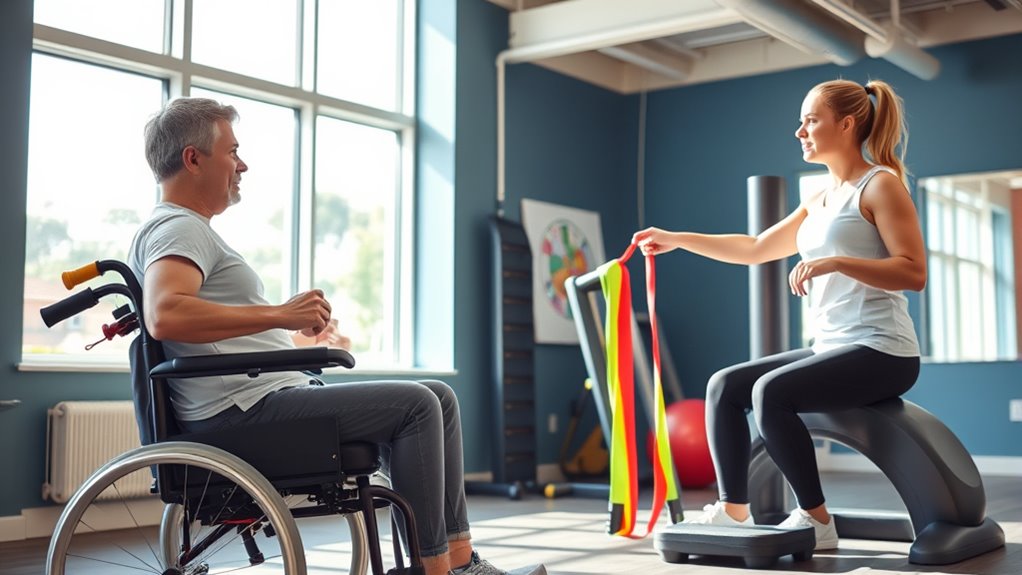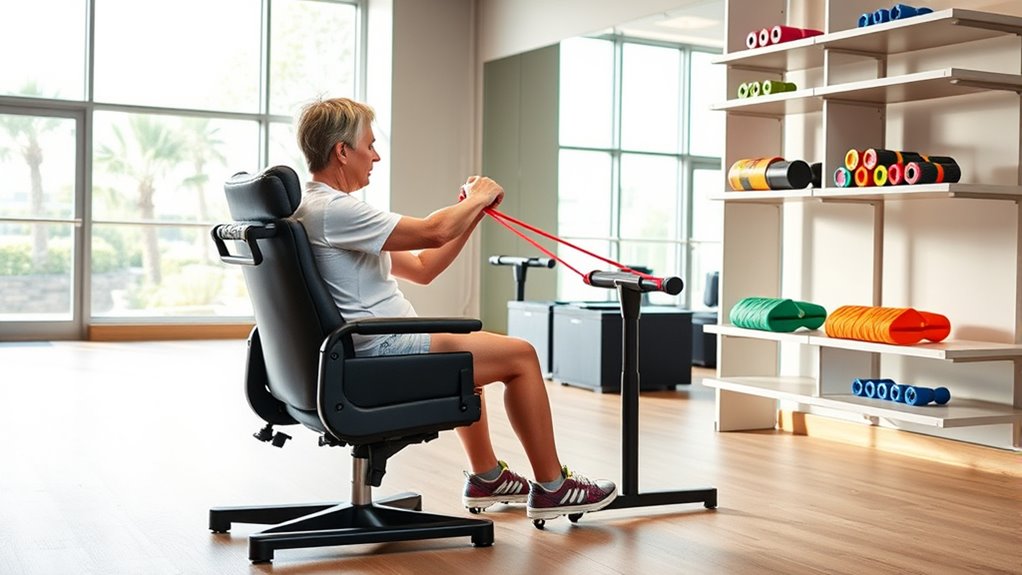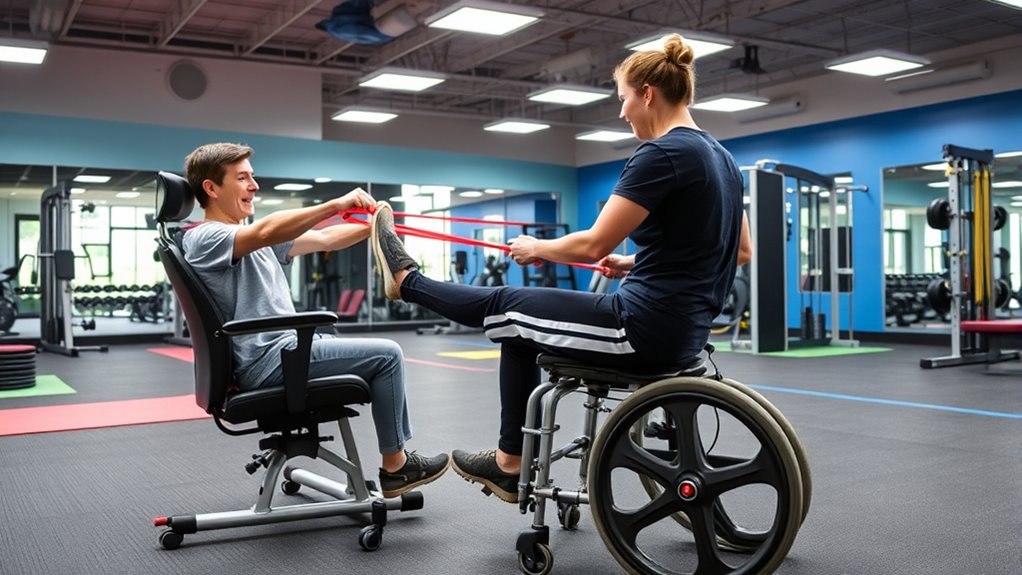To adapt circuit training for limited mobility, start by evaluating your abilities and setting realistic goals to stay motivated and prevent injury. Modify exercises into seated moves or use adaptive tools like resistance bands and specialized equipment to ensure safety and accessibility. Structure your routine with 4-6 exercises targeting different muscles, doing each for 30 seconds to a minute with rest intervals. Keep your routine engaging and consistent, and you’ll discover more strategies to stay active effectively.
Key Takeaways
- Design seated exercises targeting multiple muscle groups with adjustable durations and rest periods for safety and variety.
- Incorporate adaptive tools like resistance bands, grips, and touchless devices to enhance accessibility and ease of use.
- Use mobility assessments to tailor exercises to individual capabilities, ensuring realistic goals and progress tracking.
- Ensure routines include 4-6 exercises, repeated 2-3 times, with gradual increases in intensity or duration.
- Promote motivation through community support, celebrating milestones, and establishing routines aligned with personal lifestyles.
Assessing Individual Needs and Setting Realistic Goals

Before starting a circuit training program for limited mobility, it’s essential to assess your individual needs carefully. Conducting mobility assessments helps you understand your current capabilities and limitations. These assessments identify which adaptive techniques will work best for you, ensuring the exercises are safe and effective. Be honest about your range of motion, strength, and endurance levels. Setting realistic goals based on this information keeps you motivated and helps prevent injury. Remember, every person’s journey is unique, so avoid comparing yourself to others. Focus on what you can achieve with proper adaptations. By thoroughly evaluating your needs, you create a solid foundation for developing a personalized circuit training plan that promotes progress and confidence. Incorporating adaptive technology can further enhance your training experience by customizing exercises to your specific mobility level.
Modifying Exercises for Accessibility and Safety

Once you’ve assessed your individual needs and set realistic goals, the next step is to modify exercises to guarantee they are accessible and safe. Start by choosing seated exercises that allow you to stay stable and control movement. Use adaptive technology, like adjustable chairs or resistance bands, to tailor the workout. Consider these modifications:
- Replace standing moves with seated alternatives to reduce fall risk.
- Incorporate hand or wrist weights for added resistance without complexity.
- Use voice-activated or touchless devices to guide your routine safely.
- Adjust exercise intensity based on your comfort level, ensuring safety and progress.
These adjustments make your circuit more inclusive, helping you stay active while prioritizing safety and comfort.
Selecting Appropriate Equipment and Adaptive Tools

Choosing the right equipment and adaptive tools is essential for creating an effective and safe circuit training routine. You’ll want to select adaptive tools that accommodate your mobility needs and promote independence. Consider exercise modifications that simplify movements, like using resistance bands instead of free weights or attaching grips to handles for easier grasping. Adaptive tools such as seated pedal exercisers or adjustable-height workstations can make exercises more accessible. Focus on equipment that minimizes strain and enhances safety while providing enough challenge to build strength and endurance. Always test new tools to ensure they suit your ability level and comfort. Incorporating adaptive techniques into your routine can further improve your ability to perform exercises comfortably and effectively. By carefully choosing appropriate equipment and adaptive tools, you can customize your circuit to maximize benefits and reduce the risk of injury.
Structuring a Suitable Circuit Routine

To create an effective circuit routine for limited mobility, you need to balance variety, duration, and intensity to suit your individual needs. Start by selecting seated exercises that target different muscle groups, ensuring variety. Incorporate resistance bands for added resistance and engagement. Structure your circuit with these steps:
- Choose 4-6 seated exercises, like arm presses, leg lifts, or torso twists.
- Assign each activity a specific duration, such as 30 seconds to 1 minute.
- Rest for 15-30 seconds between exercises to recover.
- Repeat the circuit 2-3 times, gradually increasing intensity or duration as you progress. Adapting exercises can help ensure your routine remains safe and effective as your mobility level changes.
This approach keeps your routine manageable, safe, and adaptable to your mobility level.
Tips for Motivation and Maintaining Consistency

Staying motivated and consistent with your circuit training can be challenging, especially when progress feels slow or obstacles arise. To keep yourself on track, seek community support—joining a group or online forum can boost accountability and provide encouragement. Celebrating small victories helps reinforce your efforts and keeps you motivated. Regular goal tracking is also essential; note your achievements and set realistic milestones to see your progress clearly. Visualizing your goals and reminding yourself why you started can reignite your motivation when it dips. Remember, consistency is key, so establish a routine that fits your lifestyle. Engaging with adaptive exercise strategies and diligent goal tracking will help you find it easier to stay committed and enjoy the benefits of your circuit training journey.
Frequently Asked Questions
How Can I Track Progress With Limited Mobility?
You can track progress by using adaptive tools like modified activity logs or digital apps designed for limited mobility. Keep a record of your achievements, such as increased stamina or improved strength, and celebrate small milestones to stay motivated. Motivation strategies like setting realistic goals and rewarding yourself help maintain your focus. Regularly reviewing your progress and adjusting your routines keeps you engaged and encourages continuous improvement.
Are There Specific Contraindications for Certain Exercises?
When considering exercise modifications, you should be aware of specific contraindications for certain exercises. Always consult with a healthcare professional to understand any medical considerations that might limit some movements. For example, avoid high-impact activities if you have joint issues or cardiovascular concerns. Tailoring your routine guarantees safety, and listening to your body helps prevent injury. Prioritize personalized adjustments based on your health status and capabilities.
Can Circuit Training Be Combined With Other Therapies?
You might find that blending circuit training with other therapies enhances your overall progress. With adaptive equipment and professional supervision, you can safely customize your routines to better suit your needs. Combining methods maximizes benefits while minimizing risks. Always consult your healthcare team to confirm these approaches complement each other and your individual goals. This integrated approach can make your fitness journey more effective and enjoyable.
How Often Should I Update My Routine?
You should update your routine regularly to keep challenging your body and prevent plateaus. Incorporate new exercise modifications and adaptive equipment as you progress, ensuring your workouts remain effective and safe. Typically, updating every 4 to 6 weeks works well, but listen to your body. If you notice decreased motivation or results, it’s time to refresh your routine, adding variety and new adaptive strategies for continued improvement.
What Safety Precautions Are Essential During Workouts?
When you exercise, safety is key. Always use adaptive equipment suited to your mobility level, ensuring stability and comfort. Warm up properly to prevent injuries, and listen to your body—if something hurts, stop. Keep your workout area clear, and consider working with a trainer familiar with adaptive exercises for injury prevention. These precautions help you stay safe, comfortable, and motivated as you work toward your fitness goals.
Conclusion
Remember, adapting circuit training for limited mobility isn’t about pushing yourself to the limit but about safe, consistent progress. It’s natural to worry about not seeing quick results or feeling limited, but every small step counts. Focus on your personal journey, celebrate your achievements, and stay patient. With the right modifications and mindset, you’ll find joy and strength in every session, proving that accessible fitness truly empowers you to live healthier and more active.









